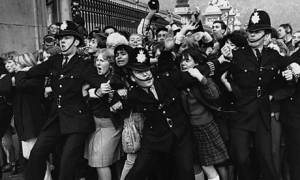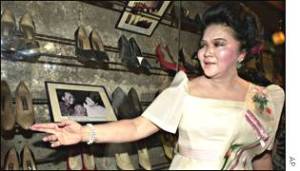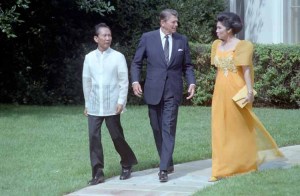Before they took off on their World Tour in June of 1966, the Beatles had put the finishing touches on their new album, “Revolver.” Click below to hear the song that would prove prescient of the “Fab Four’s” horrible experience in Manila – “Taxman.”
Monday, July 4, 1966
Manila, the Philippines, the second stop for the Beatles on their 1966 World Tour
The Manila Hotel
Manila, The Philippines:
Early in the morning, Tony Barrow, the Beatles’ publicist, and Vic Lewis, their booking agent, were awakened by sharp raps on the door of their suite. Two grim-looking men in military uniforms saluted and introduced themselves as the official reception committee from Malacañang Palace, the residence of President Ferdinand and First Lady Imelda Marcos.* They’d come to make final arrangements for the Beatles’ visit to the Palace for a luncheon hosted by the First Lady. (1)

Dictator Ferdinand Marcos with wife Imelda at his 1965 inauguration in the Philippines.
Neither Barrow nor Lewis knew what they were talking about. No one had told them that the Beatles were expected to make a presidential visit. The Beatles – John Lennon, Paul McCartney, George Harrison, and Ringo Starr – were sleeping, they explained, and couldn’t be disturbed. The band had just flown in from an exhausting concert in Tokyo. The “Fab Four” needed their rest, as they were schedule to give both afternoon and evening concerts in Manila that very day. Barrow and Lewis promised to pass along the request to Brian Epstein, the Beatles’ manager.
“This is not a request,” insisted the two men, one, a general, and the other, a commander, in the Philippine Army.

First Lady of the Philippines Imelda Marcos was a former beauty queen. Here she models a traditional gown. She regarded herself as a goddess and was used to having her way. 1963

Fashion icon Imelda Marcos descends from a flight with her son Bong Bong. Undated photo
That afternoon, the Beatles performed their hits songs to an audience of 35,000. Afterwards, Tony Barrow and others in the Beatle’s entourage filed into Brian Epstein‘s suite to watch coverage of the concert on the evening news. They were pleased to discover that every channel featured scenes of screaming, swooning fans caught up in Beatlemania. However, Channel 5, one of the country’s major networks, ran additional footage not seen on the other channels. The scene showed the First Lady at the Palace with her disappointed luncheon guests, 200 children. The voice-over said, “The children began to arrive at ten. They waited until two….The place cards for the Beatles at the lunch table were removed.” Imelda Marcos was very mad as she and her guests filed into the grand dining room without their guests of honor. The spin was that the Beatles had deliberately snubbed the President and Mrs. Marcos by not showing up.
Brian Epstein went into full damage control mode. He issued a hastily written apology to the First Couple and called an interview with Channel 5 in his hotel suite, in which he professed complete ignorance of the invitation and praised the Marcoses. An hour later, the interview was broadcast but Brian’s appearance was blacked-out by static interference. That’s when everyone started to get nervous.

ticket stubs to the Beatles July 4, 1966 concerts in Manila
Worry soon turned to panic. After their evening show, the Beatles noticed that their police escort had disappeared. When their car pulled up to the Manila Hotel, the gates were locked against them. While they sat their in the idling car, wondering how they were going to get up to their suite, several dozen “organized troublemakers” attacked their car, banging on the windows, rocking it back and forth, and shouting threats in several languages. Vic Lewis shouted at the driver: “Drive on! Go through the people and smash the gates down!” The driver obeyed. At the entrance, everyone in the Beatles’ entourage ran into the hotel with the angry mob snapping at their heels.
Shortly, an official appeared at Vic Lewis’ suite demanding payment of local taxes. Lewis produced a contract stating that someone else – the promoter – had that responsibility, not the Beatles. This was brushed aside. Until all taxes were paid, said the taxman, no one in the Beatles party was being allowed to leave the country. When the man left, Lewis found Barrow. “We’ve got to get out of here – now.” He called the bell hop for help with the luggage.
The manager told Lewis that no one would be coming to help. “The whole hotel is going on strike. They think you’ve insulted President Marcos.” Bomb and death threats were telephoned to the deluged British Embassy and to the four Beatles’ hotel suite.
The next morning, Paul had seen the newspaper headlines blaring BEATLES SNUB PRESIDENT. The Beatles had known nothing of the invitation. “Oh, dear,” he thought. “We’ll just say we’re sorry.” About then “things started to get really weird,” recalled Ringo. He and John were hanging out in their bathrobes when a roadie popped his head in their room and shouted, “Come on! Get out of bed! Get packed – we’re getting out of here.”
Everyone in the entourage grabbed amplifiers and suitcases and made for the main elevators, but they were turned off. They had to take the service lift down. The halls were dark and lined with staff who shouted at them in Spanish and English. It was very frightening. When they got downstairs to check out, the front desk was deserted. Even their cars were gone. Someone managed to get a Town Car and everyone squeezed in and made for the airport.
But the airport route was sabotaged. Soldiers were stationed at intersections and roads were closed. Finally, they found a back road that led to the airport. The airport was deserted. “The atmosphere was scary,” remembered Tony Barrow, “as if a bomb was due to go off.” Once the Beatles got on the escalator, the power was shut off. As the Beatles moved through the terminal, little bands of demonstrators appeared, grabbing at them and trying to hit them.

Mobs rough up the Beatles at the Manila airport. John Lennon is at upper corner, right. July 6, 1966
They checked in for their flight as quickly as possible then were herded into a lounge “where an abusive crowd and police with guns had also gathered.” The cops began to shove the Beatles back and forth. It was impossible to tell the thugs from the military police. According to Ringo, “they started spitting at us, spitting on us.” The Beatles hid among a group of nuns and monks huddled by an alcove. Other members of their entourage, though, were kicked and beaten.
Finally, everyone was allowed to run across the tarmac to the plane. Vic Lewis felt sure he’d get a bullet in the back. The Beatles were terrified they’d be killed before they entered the safety of the airplane. Paul said, “When we got on the plane, we were all kissing the seats. It was feeling as if we’d found sanctuary. We had definitely been in a foreign country where all the rules had changed and they carried guns. So we weren’t too gung-ho about it at all.” Ringo remembered being afraid of going to jail. Ferdinand Marcos was a dictator (who, in a few years, would declare martial law in the Philippines.)
Everyone was poised for the plane to take off when the authorities came back on board and detained Tony Barrow for thiry minutes. For the plane to be allowed to take off with the Beatles on it, Tony was forced to pay a “leaving Manila tax” that amounted to the full amount of money the Beatles had made in their concerts before 80,000 fans.
Once the plane lifted off and everyone was safely in the air, all the anger of the past 24 hours boiled over. The Beatles blamed Brian for the debacle. He’d obviously received the invitation in Japan, ignoring it or misleading the Philippine authorities.

Beatlemania. October 1965, London, England, UK. Policemen struggle to restrain young Beatles fans outside Buckingham Palace as The Beatles receive their MBEs (Member of the British Empire) in 1965.
By the time the Beatles had landed in India, they had made a command decision. This would be their last tour. They were never going to go on another tour again. Never again, swore John, was he going to risk his life for a stadium filled with screaming 13-year-old girls.
Brian said, “Sorry, lads, we have got something fixed up for Shea Stadium. If we cancel it you are going to lose a million dollars.” So they played New York’s Shea Stadium later that summer. It was the first stop on their U.S. tour, their final tour as the Beatles.

Click here to read: “Imelda Marcos Almost Gets the Beatles Killed Part 2”
(1) Spitz, Bob. The Beatles: The Biography. (New York: Little, Brown and Company, 2005)























